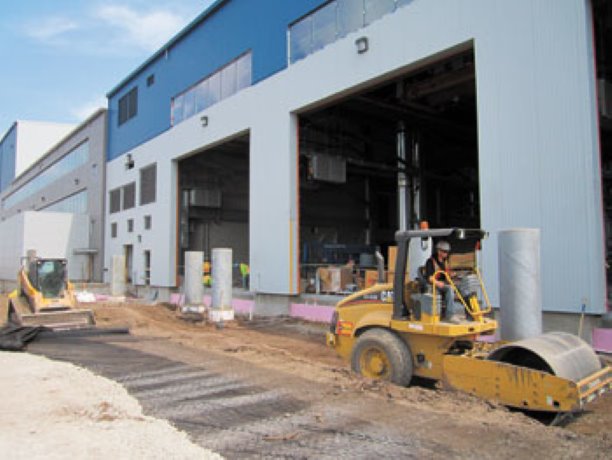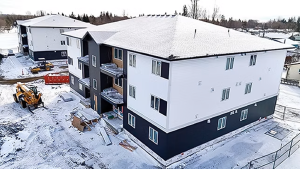Finning is expanding its mining support infrastructure in the oilsands region of central and northern Alberta by investing millions of dollars on the construction of a new 16-bay service facility in Fort McKay.
Finning is expanding its mining support infrastructure in the oilsands region of central and northern Alberta by investing millions of dollars on the construction of a new 16-bay service facility in Fort McKay.
“Today we are at 90 per cent completion and substantial completion is set for September 7,” said Shawn Tetreault, who is Finning’s facilities project manager in Fort McKay.
“Ledcor says everything is on schedule, but there are a lot of little things going on right now like paving a large vehicle bay with an 18 inch thick slab of concrete. Overall we are quite happy with the construction, but there have been a few hiccups.” Finning Canada is investing $100 million on the construction of a new 16-bay facility in Fort McKay to serve its customers and capitalize on robust demand in the mining industry near Fort McMurray.
“The facility is being built to service any of the players in the oilsands region,” said Tetreault. “It is strategically located on the north side of the Athabasca River on Highway 63, where all the growth is happening.”
Strong international demand for commodities is driving continued growth in mining, which Finning views as a significant opportunity to provide equipment and product support in the oilsands and other mining projects in BC and Alberta.
According to Finning’s first quarter 2012 financial report, revenues in Canada increased 27.1 per cent to $777.7 million compared with the first quarter of 2011, primarily due to higher new equipment sales and product support revenues.
New equipment sales in Canada jumped by 54.6 per cent in the first quarter of 2012 compared to the first quarter of 2011, due to robust growth in all sectors, but mining was particularly strong.
For example, order intake exceeded deliveries in the first quarter of 2012, primarily driven by the heavy construction and mining industries.
Product support revenues in the first quarter of 2012 increased by 10.1 per cent compared to the first quarter of 2011.
This increase was primarily driven by increased demand for parts as customers increased utilization of their fleets, which is an indicator of very strong demand in mining and heavy construction.
Finning expects capital spending on new projects and mine expansions in the oilsands region to increase the mining equipment population by about 50 per in the next five years. Some of Finning’s most important clients in the region include Suncor, Syncrude and Shell.
Construction of the new building began in March 2011 and completion is scheduled for the end of 2012. At the peak of construction, Tetreault said there were more than 100 workers on site.
“The mechanical system is the largest contract and this is definitely where we are spending money,” he said. “We need a capture system to purge exhaust, because we can’t exhaust directly on the track side (bull dozers). For graders, we have direct exhaust or point source capture, which is a hose that comes down from the ceiling.”
Tetreault said the general exhaust capture system operates using sensors that kick in and purge air when the CO2 levels are elevated. To do this the electrical contractor Torry and Sons installed a return air pipe with a diameter of 88 inches.
“What they did was ingenious,” said Tetreault. “They actually fabricated all the round duct work on site.”
The building, which is constructed of structural steel, has the main office at its core. It also has some environmental features, including a roof designed to capture 70 per cent of all rain water and store it in two tanks each with a capacity of 125,000 litres.
The captured water will be used to clean equipment in the wash bay, as opposed to trucking water in and out of the facility.
There will also be a water recycling centre, which will pull out hydrocarbons and stop water from stagnating.
“The hope at the end of the day is that the sediment at the bottom of the sump pit will be treated and not become a hazardous material,” said Tetreault.
The new facility will require about 400 employees, which will be working in shifts to service clients 24 hours a day, seven days a week. To meet this objective, Finning is currently looking to recruit about 200 new technicians and heavy duty mechanics.
Finning has also strengthened its ability to provide solutions to clients involved in the western Canadian mining through the recent acquisition of part of the distribution and support businesses of former Bucyrus International from Caterpillar for US$465 million.
The acquisition allowed Finning to obtain more than 240 employees and service facilities in Edmonton and Fort McMurray.
Caterpillar acquired Bucyrus last July for US$8.8 billion and has since been negotiating the sale of certain pieces of the business.
Finning Canada, a division of Finning International, is the world’s largest Caterpillar equipment dealer. The company sells, rents and services Caterpillar machines and engines across Western Canada, serving a diverse range of industrial markets, including forestry, construction and agriculture.











Recent Comments
comments for this post are closed